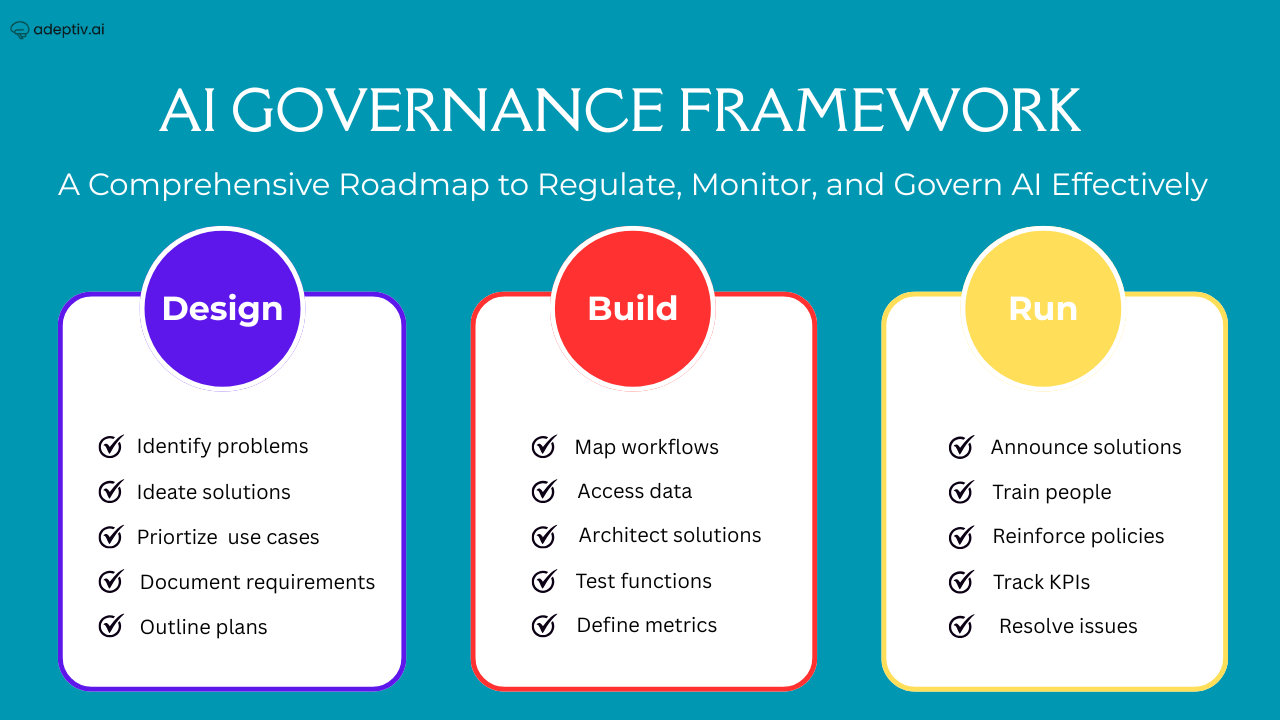At a Glance
This blog explores how AI Risk Management empowers businesses to navigate the risks and responsibilities that come with AI adoption. You’ll learn:
- Why risk management is essential in the age of AI.
- The types of AI risks businesses face today.
- How AI enhances traditional risk management.
- Global frameworks guiding responsible AI (EU AI Act, NIST, ISO 42001, etc.).
- Practical benefits, use cases, and best practices for implementing AI risk strategies.
Introduction: AI’s Promise and Its Peril
In today’s evolving technological landscape, AI has shifted from a futuristic concept to a core driver of business transformation. From automating operations to enabling advanced analytics, AI delivers unprecedented opportunities for innovation, efficiency, and competitive edge.
However, as organizations increasingly integrate AI into their processes, they also inherit new and complex forms of risks—spanning security, ethics, privacy, and compliance. If unmanaged, these risks can lead to serious reputational and legal consequences.
A recent IBM Institute for Business Value study found that while 96% of leaders are adopting generative AI, only 24% have secured their AI projects. This gap highlights an urgent need for structured AI risk management frameworks to protect business integrity and trust.
What Is AI Risk Management?
AI Risk Management is a systematic approach to identifying, assessing, mitigating, and monitoring risks associated with AI systems. It ensures that AI models are not only effective but also ethical, compliant, and secure.
AI risk management covers:
- Data Privacy & Integrity: Protecting sensitive data from unauthorized access.
- Security Threats: Preventing adversarial attacks and model manipulation.
- Algorithmic Bias: Ensuring fairness, transparency, and accountability.
- Regulatory Compliance: Aligning with global laws and standards.
When implemented effectively, AI risk management transforms governance from a reactive control mechanism into a strategic enabler of trust and innovation.
The Four Categories of AI Risks
Data Risks
AI systems depend on massive datasets, which makes them vulnerable to cyberattacks, breaches, and data poisoning.
To mitigate these, organizations must maintain data integrity, privacy, and availability throughout the AI lifecycle — from collection to deployment.
Model Risks
Attackers can target AI models directly, compromising their weights, logic, or performance. Common threats include:
- Adversarial attacks: Manipulating inputs to trigger incorrect outputs.
- Prompt injections: Forcing generative AI systems to reveal sensitive data.
- Supply chain attacks: Tampering with third-party components.
Robust model governance, validation, and continuous monitoring are essential defenses.
Operational Risks
Operational risks stem from poor accountability, weak integration, or failure to adapt AI systems.
Examples include system downtime, data drift, or non-alignment with new technologies—leading to disrupted operations and compliance issues.
Ethical and Legal Risks
Unchecked AI models can amplify bias, discrimination, and opacity, leading to legal liabilities and loss of public trust.
Organizations must embed ethical AI principles—transparency, fairness, explainability—into every phase of AI design and deployment.
The Advantages of AI-Powered Risk Management
1. Superior Forecasting Accuracy
Machine learning models capture non-linear relationships in data, offering more precise risk forecasts than traditional regression models.
2. Optimized Variable Selection
AI automates feature extraction across massive datasets, building robust, data-driven risk models for stress testing and scenario planning.
3. Richer Data Segmentation
Unsupervised ML algorithms enable advanced clustering of risk factors, revealing patterns traditional methods often miss.
4. Improved Decision-Making
By prioritizing high-risk scenarios, AI-driven systems empower leaders to make data-backed, timely, and informed decisions.
5. Operational Resilience
Real-time risk detection and adaptive mitigation foster business continuity, accountability, and long-term sustainability.
Frameworks That Guide AI Risk
As AI governance evolves, several global frameworks are defining how organizations should assess, control, and report AI-related risks. Understanding and aligning with these standards ensures compliance, transparency, and trust.
1. EU AI Act (Europe)
The EU AI Act—effective from 2024—is the first comprehensive legal framework for AI. It classifies AI systems into four risk tiers and mandates risk management, documentation, and human oversight for high-risk models.
Businesses in sectors like healthcare, HR, and finance must ensure testing, traceability, and transparency at every stage.
Focus: Risk-based classification and lifecycle accountability.
2. ISO/IEC 42001:2023 (Global Standard)
The ISO 42001 standard, published in 2023, establishes an AI Management System (AIMS) framework for responsible AI.
It guides organizations in setting up policies, documentation, risk controls, and audits for safe AI operations — much like ISO 27001 for cybersecurity.
Focus: Auditable, repeatable AI governance and risk management processes.
3. Colorado AI Act (United States)
The Colorado AI Act (SB24-205) is the first U.S. state-level AI law, emphasizing algorithmic fairness and consumer transparency.
It requires businesses to conduct bias testing, maintain AI risk management programs, and disclose AI-driven decisions impacting consumers.
Focus: Algorithmic accountability and user transparency.
4. NIST AI & Generative AI RMF (United States)
Developed by the National Institute of Standards and Technology (NIST), the AI RMF 1.0 and its Generative AI RMF draft provide voluntary but globally influential guidance.
The four-step approach — Govern → Map → Measure → Manage — ensures responsible AI deployment.
Focus: Lifecycle-based, risk-centric governance for trustworthy and generative AI.
5. Canada’s Artificial Intelligence and Data Act (AIDA)
Part of Bill C-27, AIDA governs the design and deployment of AI systems, requiring risk assessments, transparency reporting, and human oversight.
It introduces an AI and Data Commissioner to oversee compliance and accountability.
Focus: Transparency, accountability, and safe innovation.
6. Brazil’s AI Act (PL 2338/2023)
Brazil’s AI Act brings a regional approach to AI regulation, emphasizing risk classification, ethical standards, and audit mechanisms.
It aligns closely with EU principles but focuses on local governance, privacy, and inclusivity.
Focus: Regional alignment with global AI ethics and transparency.
Real-World Use Cases
1. Credit Risk Modelling
Machine learning can refine variable selection, detect patterns in borrower behavior, and improve credit scoring accuracy while maintaining regulatory compliance.
2. Fraud Detection
AI-driven systems can analyze real-time transactions, detect anomalies, and flag suspicious activities—ensuring data privacy and financial security.
3. Trade Behavior Monitoring
By analyzing communication logs and trade data, AI can identify insider trading or market manipulation, strengthening ethical and compliant trading practices.
Conclusion: Balancing Innovation with Responsibility
AI’s transformative power brings both unmatched potential and unparalleled responsibility.
Without structured governance, risks like bias, data misuse, or compliance failure can undermine even the most advanced AI projects.
Frameworks such as NIST AI RMF, EU AI Act, ISO 42001, and AIDA empower organizations to create trustworthy, transparent, and resilient AI ecosystems.
Frameworks such as NIST AI RMF, EU AI Act, ISO 42001, and AIDA empower organizations to create trustworthy, transparent, and resilient AI ecosystems.
FAQs
1. What is AI Risk Management?
AI Risk Management is the process of identifying, assessing, and mitigating risks related to AI systems to ensure safety, compliance, and trust.
2. Why is AI Risk Management important for businesses?
It prevents financial, reputational, and legal damages while building trust among consumers and regulators.
3. How does AI help in managing business risks?
AI enhances risk forecasting, detects fraud, ensures compliance, and improves decision-making through real-time analytics.
4. What are the major AI risk frameworks globally?
The EU AI Act, ISO 42001, NIST AI RMF, Canada’s AIDA, Colorado AI Act, and Brazil’s AI Act.
5. How can businesses implement effective AI risk management?
By adopting structured frameworks, investing in governance tools, and ensuring continuous testing, monitoring, and documentation.



